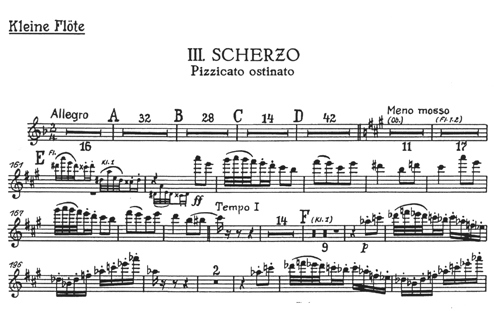
Just uttering the words Tchaikovsky #4 causes every piccolo player to feel a sudden imbalance in the fabric of the universe. This phenomenon has not been scientifically studied yet, but asking any piccolo player about this legendary part inevitably leads to a grimace, laughter, fear, amusing stories, or a combination of them all.
This past summer, my first reaction to being assigned the piccolo part involved a lot of excited jumping up and down. When I received the music, I was thrilled. That is, until I realized I had not studied this excerpt in two years; I had never played a standard excerpt in an orchestra; and the concert was in nine days.
Symphony No. 4 in f minor, Op. 36 was written in 1877-1878. The piccolo part itself begins in the third movement (the piccolo is tacit for the first two movements) after about 33 minutes of waiting. The infamous ornamental motif requires crisp technique and crystal clear articulation. Careful tuning in the woodwind section is essential, and then there is always the matter of precise rhythm. Executing this on the first try, after sitting for over half an hour, is a struggle.
Immediately preparation became the name of the game. For the next nine days I ate, slept, and breathed Tchaikovsky. Everything I did was carefully crafted to facilitate nailing those pesky solos in the performance. Harmonics, random practice, chunking, and mental practice were my go-to tools.
Harmonics
I practiced harmonics to build and refine my embouchure – the most important step in my preparation. Without a well-functioning embou-chure, there is no hope of even beginning the solos, much less playing them in tune. My days started on the flute practicing every harmonic exercise I could think of. I slurred from one partial to the next memorizing what I had to do to get them to speak clearly. Then I changed to piccolo and practiced switching from a third harmonic partial to the real fingering while striving for a constant, controlled embouchure. It was loud, irritating work, and I am sure some of my colleagues still want to snap my piccolo in two, but my embouchure improved drastically by performance day.
Random Practice
Earlier this summer I attended a lecture on practicing given by Molly Gebrian, a violist and neuroscientist. One of her suggested practice techniques is called random practice. The goal of random practice is to play the passage perfectly on the first try as there are no second chances in a performance.
First I identified my problem which was getting the very first A7 (sounding A8) to speak well without fail. After all, if I flubbed this A, the rest of the solo was doomed. The plan was to play the problem spot one time. If I made a mistake, I did not play the passage again, but instead analyzed what went wrong. Then I practiced a different piece of music. In five minutes, I returned to the problem spot again playing it once, trying to fix whatever previously had gone wrong. I repeated this sequence throughout my practice session.
It is a painful way of practicing as the odds are you will sound dreadful for a while. I couldn’t even get the A to sound at first. Within a day or two, however, I had mastered the A, and was throwing out entire phrases at the drop of a hat. It was amazing. Random practice forces one’s brain to focus at a high level, facilitating faster, more effective learning. Plus, it allows you to get far more done in the same amount of time since you have to practice something else in addition to the problem spot. While mastering that A, I was also drilling scales, Mozart Concerto in G, and the rest of Tchaikovsky Four’s piccolo part.
Chunking
Speaking of the rest of the part – what a technical challenge it is. Unisons with the violins are common, and the first ornaments are ridiculously fast. To tackle this, I turned to chunking, a practice method coined by Patricia George. To chunk, set the metronome to a challenging or performance tempo. Break the problem section into chunks – small, manageable groups of notes. Chunking by beat is a good place to start. Play each chunk with the metronome and rest an equal amount of time between the chunks. I spent hours playing groups of two notes at a time, simply moving back and forth between them as cleanly and quickly as possible until I knew every change like the back of my hand. In the following days, I strung chunks together, and was soon executing entire phrases cleanly despite my limited practice time. Like random practice, chunking forces one’s brain to focus and to focus on one specific thing before moving on to the next. Efficient learning is simply a matter of keeping one’s brain engaged.
Mental Practice
Practicing the piccolo all day long is not healthy and probably leads to insanity. Mental practice can be done without limit. All that is required is to imagine every single aspect of one’s playing during a passage and ask such questions as: “What is my air doing?” “How is my embouchure set?” and “What are my fingers doing?” Any unclear answers should be isolated and analyzed so that everything becomes second nature. It may seem silly, but mental practice has the same physical effect on one’s brain as traditional practice, according to Gebrian’s lecture. I used mental practice to solidify my rhythm in the third movement where the thirty-second note ornaments are quite fast. I wanted them clean and accurate so I practiced mentally while doing things like traversing campus or brushing my teeth.
On performance day, I knew I had done everything I could in terms of preparation. This calmed my nerves a bit, but I was still tense. The entirety of the first movement was spent desperately trying to slow down my heart rate – but with no success. During the second movement I gave up, decided to accept it, and just listened to the music being made. It was beautiful. The accompaniment part, especially, drew my attention. The harmonies in the Andante are rich, sorrowful, and strangely determined. I let them wash over me and particularly enjoyed the second clarinets behind me, who have notes that fit quite wonderfully into the existing chords.
This put me more at ease than I have ever been in a performance. By the third movement, I was ready to go. When the time came, I spun that whirling melody over the orchestra. Of course I heard things I wanted to improve, but reviews from the conductor, music festival faculty, and friends were all glowing.
The piccolo part to Tchaikovsky’s Fourth is a beast. It is virtuosic and the sheer amount of rests requires an iron will. Despite (or perhaps because of) these struggles, it is an incredibly rewarding part to play, and the hard, organized work put into it is rewarded tenfold at the performance. To the players given the responsibility of executing it: It can be done! Embrace it, love it, and enjoy it.






